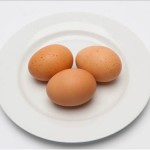This dish originates from ancient Rome, when it was served at the start of a meal. You could make them for a snack, a packed lunch alternative or serve them with a salad to make a meal. Try adding cooked diced bacon into the mix as an alternative.
Skills Check
Follow a recipe; follow food safety & hygiene rules; tidy away; use measuring spoons; cut using the bridge/claw technique; mash; season to taste; garnish; use a hob (with adult supervision).
Equipment
Saucepan, table knife, chopping board, measuring spoons, fork, spoon, bowl, serving plate.
Allergens (Please note the allergens listed are indicative only. Allergens vary depending on brand; check the labels on the products you use)
Mustard | Eggs | Milk | Sulphites
Ingredients (serves 4):
- 4 eggs
- 1 tbsp of reduced fat or ‘light’ mayonnaise
- 1/2 tsp mustard
- Black pepper
- 1 tsp paprika, to serve
Method
- Bring a saucepan of water to the boil. Gently lower in the eggs and boil them gently for about 10-12 minutes, then allow to cool (or place in a bowl of cold water).
- Peel the eggs and slice them lengthways.
- Remove the yolks carefully with a teaspoon and put them in a bowl.
- Mash the yolks with the back of a fork.
- Add the mayonnaise, mustard and pepper to the yolks and mix together.
- Gently spoon the mixture into the hollows of the egg whites and sprinkle the paprika over the top.
- Arrange them on a plate and serve.
So thinking about devilled eggs...

Mayonnaise can be high in calories. Use small amounts and choose low fat options where possible.
Nutritional Information
| Energy | 442kJ/106kcal | 5% | |
| Med | Fat | 7.8g | 11% |
| Med | Saturates | 1.8g | 9% |
| Low | Sugars | 0.5g | 1% |
| Med | Salt | 0.41 | 7% |
per 67g serving
% of an adult's reference intake
Typical values per 100g: Energy 660kJ / 159kcal
Notes
A traffic light system is used on nutrition labels to make it easier to see which foods and drinks are lower in calories, fat, sugar and salt. Try and choose more ‘greens’ and ‘ambers’ and fewer ‘reds’, and stick to smaller portions of ‘reds’.
Just because a recipe or a food has a red traffic light doesn’t mean you shouldn’t eat it. Understanding why a food or recipe might have a red light can be helpful. For example oily fish is high in total fat and so any recipe containing oily fish is likely to be ‘red’ for fat. But it is recommended that we eat oily fish at least once a week because the type of fat it contains is beneficial for our health.
% Reference Intakes are also shown. Reference Intakes are guidelines about the approximate amount of particular nutrients and energy required for a healthy diet (based on an average-sized woman doing an average amount of physical activity). Most children will require less than these Reference Intakes. The contribution of one serving of a food or drink to the Reference Intake for each nutrient is expressed as a percentage.



